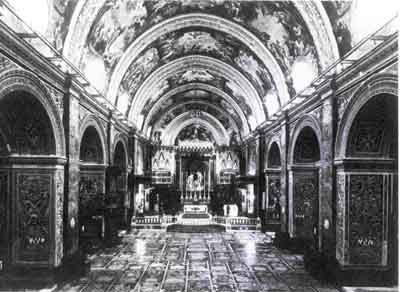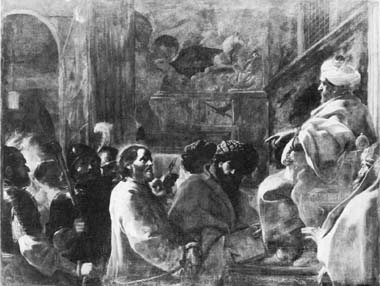
Annual Bulletin 1, 1977-1978
Home
Français
Introduction
History
Annual Index
Author &
Subject
Credits
Contact


Mattia Preti: The Feast of Absalom
by John T. Spike
Pages 1
| 2 | 3
| 4
| 5
| 6
When Preti left Naples for Malta, probably desirous
of a respite from controversy, he worked en route at Valmontone
(near Rome) in the spring of 1661. The application of his new ideas of
pictorial composition to fresco decoration produced a result we now term
Late Baroque. Especially appropriate to a relatively low-ceilinged room,
Preti's Allegory of Air (in the now-ruined, but restorable Stanza
dell'Aria, Palazzo Doria-Pamphili, Valmontone) creates a sense of expansiveness
by the equal emphasis on each figure seemingly floating at random across
the vault.
The paintings on the apse, vault, and interior façade
of the Knights' Church of St John, Valletta, Malta, were Preti's chief
activity from his arrival in 1661 until their completion in December 1666
(see fig. 2). For our purposes, the St John decorations provide a most
helpful chronological framework for the dating of Preti's easel paintings
of those years. We must therefore review the history of the project in
some detail. De Dominici' s account is his usual mélange of
fact and fantasy. (7) Fortunately, Preti's progress is revealed reasonably well by the documents discovered in the Archives of the Knights of Malta
by Mifsud in 1913 (8) and Valerio Mariani in 1928. (9) Invaluable in the extreme
are Preti's own letters to the Sicilian nobleman and collector, Don Antonio
Ruffo. (10)
On 18 September 1661, Preti wrote to Ruffo that he had submitted
his plans for the embellishment "of the painting
as well as for the architecture" of the Church of St John .Three days
before, Preti had been elevated to the Knighthood of Grace in accordance
with a letter sent by Pope Alexander VII to the Order.
On the last day of September an ad hoc committee
of Knights reported its findings to the Council of the Order. The
committee praised Preti's ideas for the paintings of the life of St John
the Baptist and other sacred stories. However, his proposals to increase
the amount of light in the interior were rejected as structurally dangerous.
Only the window in the façade over the main door was judged safe
for enlargement.
Preti commenced his work immediately. He explained to Ruffo in
mid-December 1661 that a promised picture was still un finished
because of his preoccupation as much with "'the intaglio decorations
which are following my design as with the paintings" for St John's. This
first stage of the works was complete before the year was out. Preti proudly
reported to Ruffo on 2 January 1662 that his efforts had been applauded
by the Grand Master and rewarded with a gold chain worth 600 scudi. It
would seem that this award followed the completion of the carved ornamentation
and possibly the painting in the apse.
All writers have assumed that Preti first painted the apse scene of
St John the Baptist Receiving the Standard of the
Order, though this is not fully documented. On grounds of style, this
view is the most reasonable. Sir Hannibal Scicluna, in his standard history
of the church, states that the apse painting was unveiled on St John's Eve
(23 June) 1662 in a grand ceremony that is "described in detail in the Archives,"
but does not cite the volume. (11)
Probably following De Dominici, it has further been
assumed that Preti next painted the great lunette, Triumph of the Order
of St John, and the adjacent arch over the façade. Mariani overlooked
his own discovery that the Council did not grant final authorization for
the enlargement of the façade window and the carving of its gilded
molding until 3 March 1664. The present window is an integral part of Preti's
composition and could not have been altered after his work. Moreover, in
the lunette Preti portrays the brothers Raphael Cotoner, at right, and
Nicholas Cotoner, left, each in the habit of Grand Master. Nicholas did
not assume the office until 23 October 1663, when Preti had already finished
some sections of the vault.
On 17 June 1663 Preti received another payment
of a gold chain, this time worth 300 scudi. The following September,
Preti wrote to Don Antonio Ruffo that he had been given this chain upon
the uncovering of the' 'third part" of the work of St John 's. Preti had
divided the vault of St John' s into six sections, corresponding to the
chapel entrances below. In each section he painted three scenes separated
by illusionistic architecture. Since we know that he had not yet begun
the lunette, this "third part" was either the second or the third section,
depending on whether Preti was counting the apse as a "part." All the
St John's decorations were completed by December 1666.
It is extremely difficult to draw comparisons between
Preti's paintings on canvas and his vault decorations which we can only
study from a considerable distance. (Our task would have been aided immeasurably
had a comprehensive campaign of photography been mounted simultaneously
with the cleaning a decade ago.) Preti succeeded in creating of the
vault a harmonious decoration despite the passage of five years and the
remarkable developments in style noticeable in his easel paintings. Perhaps
the only evolution that can be observed in the vault is that the figures
tend to become slightly smaller and more apt to be joined in groups as
Preti proceeded from portal to altar.
Among the few works that are clearly connected
with a vault scene is one of two paintings by Preti found in the parish
church of Sambughè, a town near Treviso in northern Italy. These
were donated to the church in 1667, (12) The composition of the
Sambughè Christ bejore Herod (fig, 3) is derived, or vice versa,
from the episode of John the Baptist Rebuking Herod on the left side
of the fifth section of the vault, the date of which can be estimated at c. 1665.
The key to this identification is the distinctive expression
of the two protagonists and the frail bodies entrusted with bearing
such spirituality. The Christ and the shepherd Baptist command attention
not through their robust physiques as elsewhere in the vault, but from
the intense gazes emanating from their small, deep-set eyes.
Next Page | Christ
and the Woman of Samaria
1
| 2 | 3
| 4
| 5
| 6
Annual Index | Author & Subject | Credits | Contact
This digital collection
was produced under contract to Canada's Digital Collections program,
Industry Canada.
"Digital
Collections Program, Copyright
© National Gallery of
Canada 2001"